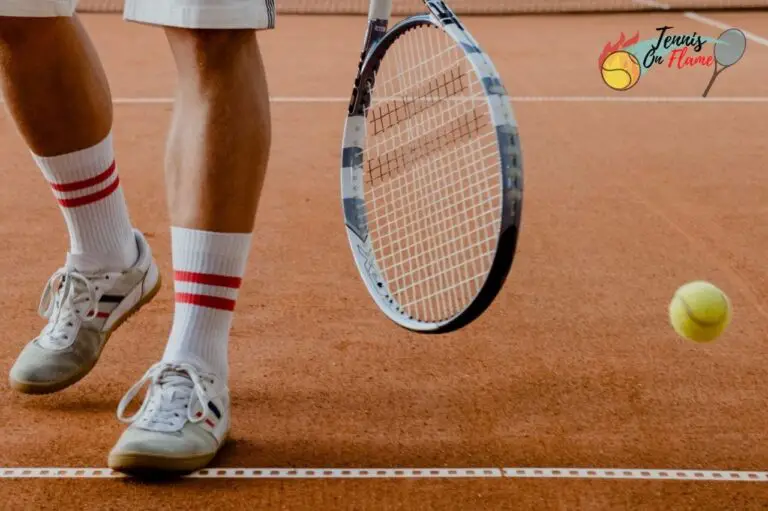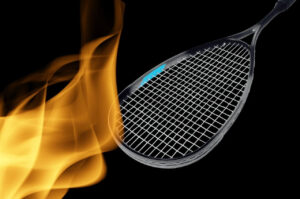Before you ask yourself “Are tennis rackets made from catgut?” – do you know what catgut is? If you’re a tennis player, there’s a good chance that your racket is made from it!
Catgut is the material that tennis rackets are traditionally made from.
It’s strong and flexible and provides great shock absorption.
In this article, we will discuss the history of catgut tennis rackets and why they are still used today.
We will also take a look at some of the alternative materials that are now being used to make tennis rackets.
So, whether you’re a beginner or an experienced player, read on to learn more about catgut tennis rackets!
What is Catgut?
Catgut is a type of cord that is made from the intestines of animals.
It can be made from the intestines of cows, horses, sheep, or goats.
The best quality catgut comes from young animals.
Catgut was first used to make strings for violins and other stringed instruments.
It wasn’t until the early 1800s that catgut was first used to make tennis rackets.

Are tennis rackets made out of animal intestines?
Yes, many tennis rackets today are made from catgut.
Catgut is a strong and flexible material that provides great shock absorption.
After all, It’s been used to make tennis rackets for over 200 years!
Why are Tennis Rackets Made From Catgut?
There are a few reasons why tennis rackets are traditionally made from catgut.
First of all, the catgut is strong and flexible. It can withstand a lot of wear and tear, which is important for a tennis racket.
Second, the catgut provides great shock absorption. This is essential for protecting the player’s arm from the impact of the ball.
Finally, catgut is affordable and easy to work with. It can be twisted and stretched to create the perfect racket shape.
Do they still use catgut for tennis rackets?
Yes, catgut is still used to make tennis rackets. However, there are now several alternative materials that are also being used.
Some of these materials include graphite, titanium, and Kevlar.
Which material is best for a tennis racket?
That depends on your personal preferences. Some players prefer the feel of a catgut racket, while others prefer the power and durability of a graphite racket.
It’s really up to you to decide which material is best for your game.
Alternative Materials for Tennis Rackets
While catgut is still the most popular material for tennis rackets, there are a few alternative materials that are now being used.
One of these materials is carbon fiber. Carbon fiber is strong and lightweight, and it doesn’t absorb as much shock as catgut.
As a result, carbon fiber rackets are becoming increasingly popular among professional players.
Another alternative material is aluminum. Aluminum is strong and lightweight, and it doesn’t absorb shock as well as carbon fiber.
However, aluminum is less expensive than carbon fiber and it’s easier to work with.
So, it’s a good option for beginner players.
What Fibre is used in tennis rackets?
The fiber used in tennis rackets is typically catgut, Kevlar, graphite, or aluminum.
Each material has its benefits and drawbacks, so it’s important to choose the right one for your game.
Catgut is strong and flexible, while Kevlar is very strong but lacks flexibility. Graphite is lightweight and durable, while aluminum is strong and lightweight.
It’s up to you to decide which material is best for your needs.
How do you string a tennis racket with a natural gut?
Stringing a tennis racket with a natural gut is a fairly simple process.
First, you need to remove the old strings from the racket.
Then, you need to tie one end of the new string to the bridge of the racket.
You can do this by making a loop and tying it in a knot.
Then, you need to thread the other end of the string through the hole in the racket head.
You can do this by using a needle or a sharp object like a pen.
Once the string is through the hole, you can start winding it around the frame of the racket.
Make sure that you wind it tightly and evenly.
When you reach the end of the string, tie it in a knot.
You can then cut off any excess string.
How do you care for a tennis racket with a natural gut?
Caring for a tennis racket with a natural gut is fairly simple.
First, you need to make sure that the racket is clean. You can do this by wiping it down with a damp cloth.
Then, you need to apply some string wax to the strings. This will help them stay in good condition.
You can find string wax at most sporting goods stores.
Finally, you need to store the racket in a safe place. You can do this by putting it in a racket case or wrapping it in a towel.
Which tennis players use a natural gut?
Some of the most famous tennis players who use natural gut include Roger Federer, Rafael Nadal, Serena Williams, Grigor Dimitrov, and Kei Nishikori.
These players swear by the power and feel of a natural gut racket, and they believe that it gives them an edge on the court.
Are there any benefits to using a tennis racket with a natural gut?
There are a few benefits to using a tennis racket with a natural gut.
First, the natural gut is very flexible and absorbs shock well. This helps reduce the risk of injury.
Second, the natural gut provides good feedback to the player. This means that you can feel the ball better and make more accurate shots.
Third, the natural gut is durable and can last for a long time.
So, if you’re looking for a good all-around racket, a natural gut may be the right choice for you.
How are catgut strings made?
Catgut strings are made from the intestines of sheep, cattle, or horses.
The intestines are cleaned and then dried out.
They are then cut into small pieces and boiled in water.
The boiling process loosens the fibers in the intestine, which are then strained out and cooled.
The resulting strings are then twisted into a cord and tied into knots.
Catgut strings are very strong and durable, but they tend to lose their elasticity over time.
So, you may need to replace them occasionally.
Is catgut a good choice for beginners?
Catgut is not a good choice for beginners because it’s less durable than synthetic gut.
If you’re a beginner, it’s best to stick with synthetic gut until you get more experience playing tennis.
What tennis string is closest to the natural gut?
There is no perfect replacement for the natural gut, but some players say Multifilament strings come the closest.
Multifilament strings are made from several small fibers twisted together, which gives them a similar feel to the natural gut.
They are also more affordable than natural gut strings.
What is the difference between synthetic and natural gut?
The main difference between synthetic and natural gut is that synthetic gut is cheaper and more durable.
Natural gut, on the other hand, is more expensive but provides better feedback to the player.
Which one you choose depends on your budget and playing style.
How do I naturally string my gut?
If you want to string your gut yourself, you’ll need some basic supplies.
You’ll need a needle or a sharp object like a pen, some string wax, and a tennis racket.
First, cut the end of the string off so that it’s about 18 inches long.
Then, thread the string through the needle.
Next, tie a knot in the string about an inch from the end.
Make sure that the knot is tight and won’t come undone.
Now, you’re ready to start stringing your racket!
Start by threading the needle through one of the holes in the frame of the racket.
Make sure that the knot is on the inside of the racket.
Then, pull the string through until it’s tight.
Now, do the same thing with the other hole in the frame.
Once you have both strings in place, tie a knot in between them to hold them together.
Finally, apply some string wax to the strings to keep them from unraveling.
How often should I restring my gut?
You may need to restring your gut every few months, depending on how often you play tennis.
If the strings start to lose their elasticity, it’s time for a new set.
Stringing your racket is a quick and easy process, so it’s worth doing it yourself to save some money.
In conclusion,
there are a few benefits to using a tennis racket with natural gut strings.
They are very flexible and absorb shock well, providing good feedback to the player. They are also durable and can last for a long time.
If you’re looking for a good all-around racket, a natural gut may be the right choice for you.
Catgut strings are made from the intestines of sheep, cattle, or horses.
The intestines are cleaned and then dried out. They are then cut into small pieces and boiled in water.
The boiling process loosens the fibers in the intestine, which are then strained out and cooled. The resulting strings are then twisted into a cord and tied into knots.
Catgut strings are very strong and durable, but they tend to lose their elasticity over time.
So, you may need to replace them occasionally.
So there you have it – everything you need to know about tennis rackets made from catgut!
Whether you’re a beginner or an experienced player, this information will help you choose the right racket for your needs. Thanks for reading!








